Types of Bullying
Types of Bullying
Types of bullying – both how the bullying occurs and who the bully is – require different responses from parents. Here we’ll cover:
- Verbal and physical bullying
- Cyberbullying
- Peer-to-peer bullying
- Teacher-to-student bullying
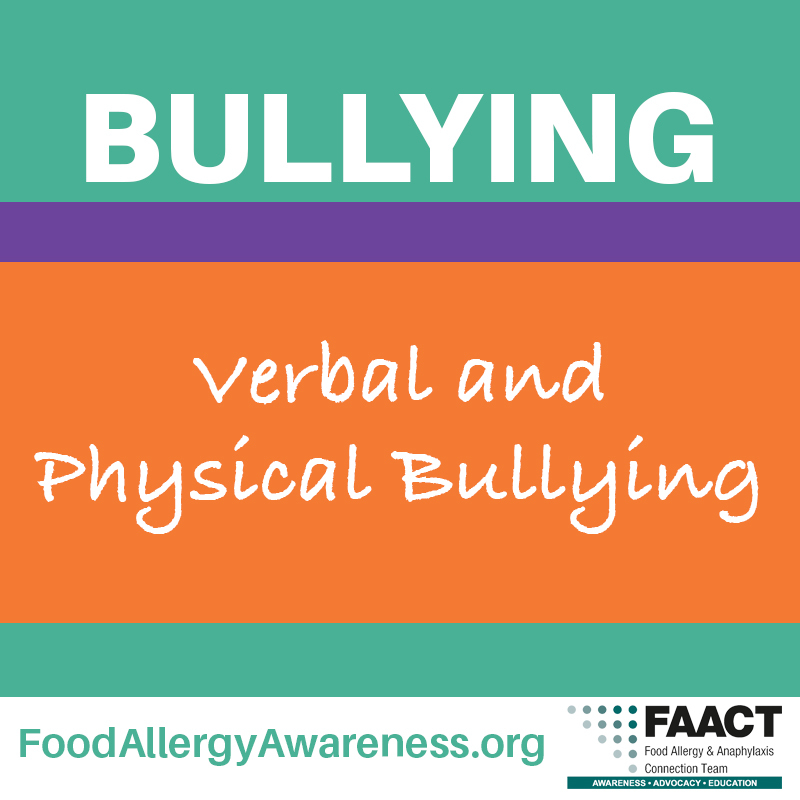
Verbal & Physical Bullying
The most common type of bullying is verbal and physical. Statistics show that this form of bullying happens mostly during middle school. When a food allergic student is bullied, there should be appropriate consequences for the bully.
Warning signs that your child is being verbally or physically bullied at school can include:
- Avoiding certain areas. For example, a student may avoid eating in certain areas of the school cafeteria, avoid eating at certain times, or not eating at all during school.
- Lunchbox repeatedly coming home full, indicating possible food avoidance.
- Changes in behavior, such as risky eating behaviors by a child who was once a careful label reader.
You can find more warning signs on our Bullying Signs & Symptoms page.
The Parent/Caregiver Role
Parents/Caregivers should report bullying incidents to the school administrator promptly. If an allergen was used to bully a food-allergic student, you may want to involve local authorities given the serious health consequences of anaphylaxis and the physical nature of the assault. Take into account the age of the child who physically bullied your child with an allergen. Younger children may not realize the possible fatal consequences of anaphylactic reactions. Therefore, it may be appropriate to have the school manage the disciplinary response for a young student.
Do not ignore the bullying, no matter the age of your child or the bully. Ask school staff not to speak with both your child and the bully together and to ensure the bully is kept away from your child during the investigation to keep your child from being bullied further and possibly intimidated into recanting his or her statements about the bully. One look from the bully could be all it takes to make the food-allergic student fearful enough to keep quiet.
Other tips for parents/caregivers include:
-
If your child has an IEP or 504 Plan, request an IEP or 504 meeting and review the incident. It may be appropriate to include accommodations to address your child’s individual needs further (see Dear Colleague Letter). This is especially important for reentry into school after an incident has resulted in a reaction. Accommodations to address reentry should be detailed.
-
Maintain your child’s regular schedule to provide comfort and familiarity. This is especially important due to the student having knowledge of trained staff and knowing who to go to for help.
-
Speak with the school counselor about ways to educate your child’s classmates, when appropriate, about food allergies.
Find Out What Happened and Respond on the Spot
FAACT
Verbal abuse is the most common form of bullying for food-allergic children.
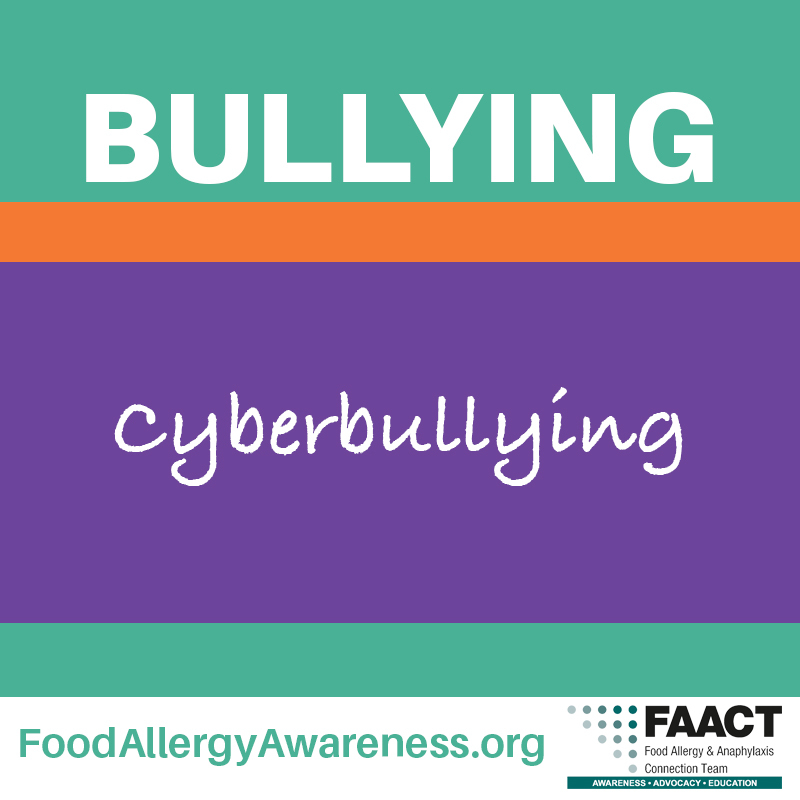
Cyberbullying
Cyberbullying is the “willful and repeated harm inflicted through the use of computers, cell phones, and other electronic devices.” [2] Cyberbullying can include spreading rumors through social media sites such as Facebook, Twitter, or Instagram; send harassing text messages or e-mails; or post embarrassing pictures on the Internet through social media.
Warning signs of cyberbullying include if a child/teen:
- Unexpectedly stops using his or her cell phone or the computer.
- Appears nervous or jumpy when an instant message or e-mail appears.
- Appears uneasy about going to school or leaving the house in general.
- Is angry, depressed, or frustrated after using the computer or cell phone.
- Avoids discussions about what he or she is doing on the computer or cell phone.
- Becomes abnormally withdrawn from usual friends and family members.
A child or teen may be engaging in cyberbullying if he or she:
- Quickly switches screens or closes programs when a parent walks by.
- Gets unusually upset when cell phone privileges are restricted.
- Avoids discussions about he or she is doing on the computer or cell phone.
- Appears to be using multiple online accounts or an account that is not his or her own.
The Parent/Caregiver Role
Experts recommend that parents/caregivers talk with children about their online activity. Parents/caregivers should educate their children about the potential dangers of sharing too much information online. It is important that parents establish an open line of communication with their children so that if any problems do occur, parents can respond to quickly and appropriately. It is also important to consult the child being bullied about how he or she wants to resolve the situation.
If a cyberbullying incident has occurred, it may be appropriate to contact the school. Even if the incident did not take place on school property or during school hours, teachers and school administrators should be aware of a potentially problematic situation. Most children who are engaging in cyberbullying also bully children verbally or physically at school. Informing school administrators will allow them to investigate whether any other incidents may have occurred during the school day.
Many states have anti-bullying laws and policies in place that include cyberbullying. If your child has been involved in a cyberbullying incident, check your state laws for additional information.
FAACT
16 percent of high school students (grades 9-12) were cyberbullied in the past year. Research on cyberbullying is growing. However, because technology use changes rapidly, it is difficult to design surveys that accurately capture trends.
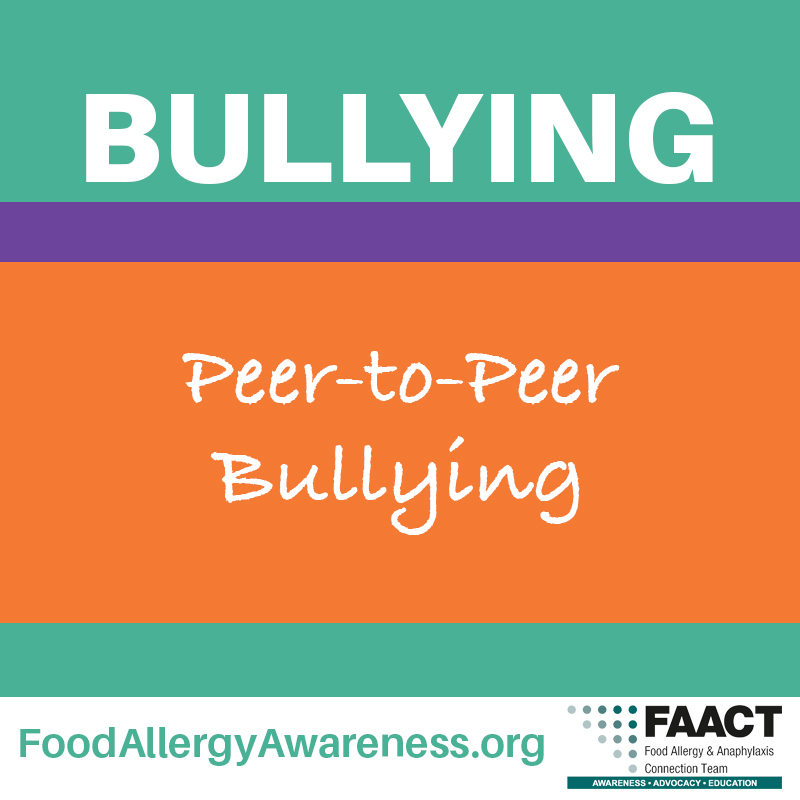
Peer-to-Peer Bullying
Bullying of children with food allergies is unfortunately common and is associated with a lower quality of life and higher rate of anxiety for the child being bullied. It can result in emotional distress for both the child and parents/caregivers as well as physical harm to the bullying victim. However, when parents/caregivers know about the bullying, bullied children have an improved quality of life and less distress.
The Parent/Caregiver Role
While no one can predict when and where bullying will occur, parents/caregivers play an important part in reducing the risk of bullying. They can help their child build and strengthen peer relationships. Encourage peer relationships outside the school environment and the buddy system inside school can help reduce bullying incidents. Studies show that peers bully others who either appear “different” or who are alone. For example, if a child has many friends and doesn't spend much time alone at a locker, in the hallways, or at the playground, that child has less chance of being bullied.
Tips and activities to improve a child’s peer relationships:
- Parents/Caregivers should, if possible, be present at their child’s school. Research shows that 67% of bullying happens when adults are not present. Help schools that may not have resources available to keep an eye on every student. When parents help staff with some of the workload, it may free staff to be able to pinpoint bullying behaviors.
- Sign children up for sports activities. Then invite friends from the team to your home or to another activity outside sports games.
- Sign children up for special interest activities such as a Lego® League, art or music lessons, or martial arts class. Then invite friends from the activity to your home.
- Invite new classmates to your home to show them how similarly everyone really lives.
FAACT
In a survey of bullying incidents among children with food allergies, 82 percent of the incidents were carried out by other students, most often at schools.
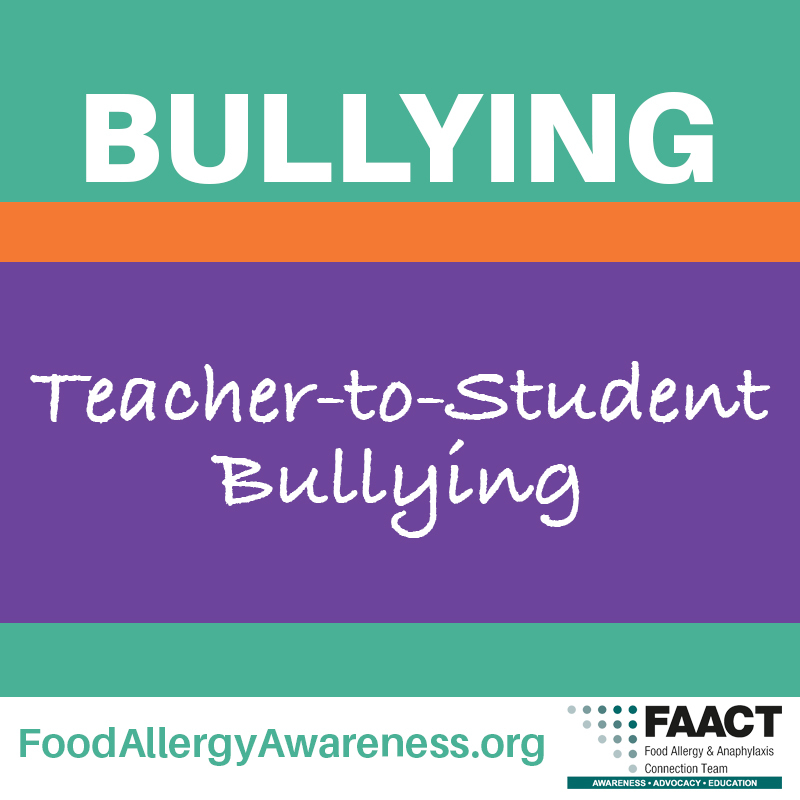
Teacher-to-Student Bullying
It may be hard to believe, but some incidents of bullying children with food allergies occur due to school staff. There are limited studies on teacher-to-student bullying. However, these studies reveal that the teachers who bully were either bullied themselves during childhood, were being bullied in the workplace, or observed bullying among their peers.
A 2005 study[3] examined the relationship between teachers who bully students and behavioral problems that caused students to be suspended from school. Results showed that in schools with high rates of student suspensions, the teachers bullied more students. Additionally, these teachers had experienced more bullying when they were students, they had worked with more teachers who had bullied others over the past three years, and had seen more teachers bullying over the past year.
Another study conducted in 2006[4] examined elementary school teachers’ perceptions of bullying by other teachers. The results showed that teachers who were bullied as children were more likely to bully students and be bullied by students both inside and outside the classroom. The study classified two types of teacher who bully: a sadistic bully and a bully-victim
The Parent/Caregiver Role
Being bullied by a teacher can result in mental trauma for the student. It affects childhood development and carries through adulthood.
Students with food allergies may be bullied by teachers when school staff are not taught how to appropriately respond to accommodations needed by a food-allergic student and the dangers of food allergies themselves. If the bullying seems to be more a problem of lack of knowledge, parents can approach the teacher directly to raise the issue, if you feel comfortable doing so. Otherwise, or if the response is not immediate and appropriate, take the issue to school administration.
If your food-allergic child is being outright bullied or harassed by a teacher, the first step is to document the incident(s). If your child is in physical danger due to a teacher, immediately contact school administrators and local law enforcement. If the harassment is verbal or more subtle, you will need to provide proof of a pattern of abuse. Talk with your child’s classmates – those with food allergies and those without – and their parents/caregivers to learn more about what does on in the classroom and whether other students are having problems with this teacher. If possible, spend time volunteering at the school to be present for your child and to establish rapport with school personnel. When you have documentation of the bullying, ask office personnel the chain of command you should follow for reporting such incidents.
In addition, it’s important to let your child know that bullying by a teacher is never acceptable and that you will work with your child to resolve this. You may have to consider transferring schools if your child’s school is unwilling or unable to resolve the issue with the bullying teacher.
FAACT
20 percent of food-allergic students were teased or harassed by a teacher or other school staff.
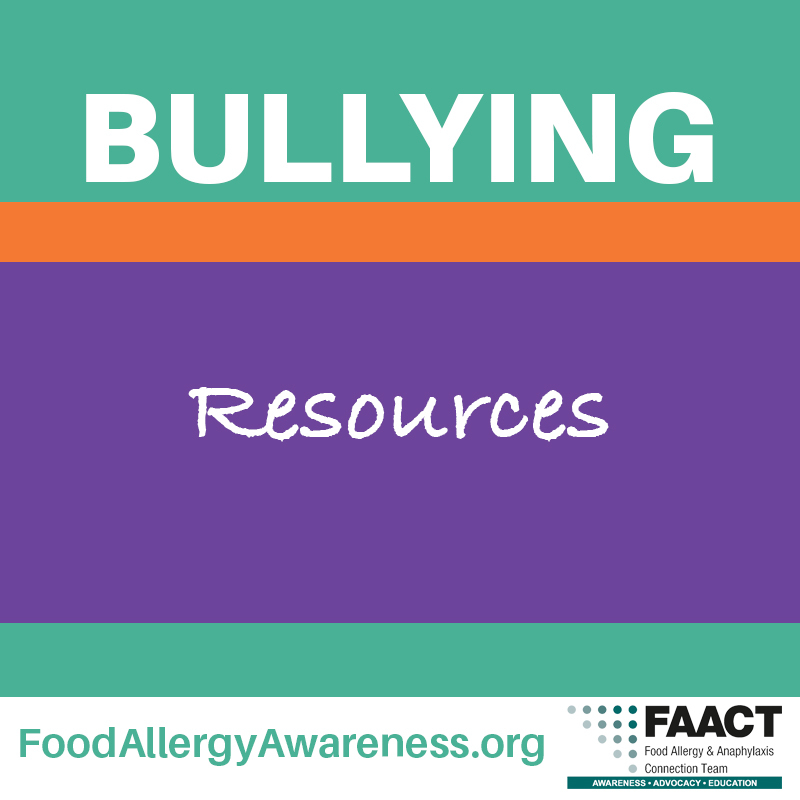
Resources:
- Cyberbullying: Identification, Prevention, and Response Fact Sheet (PDF link)
- Cyberbullying: Resources for Parents
- Cyberbullying Scripts: Talking to Teens About Online Harassment
- Great Schools: When the Teacher is the Bully
- StopBullying.gov: What Is Cyberbullying?
- StopBullying.gov: State Anti-Bullying Laws and Policies
- StopBullying.gov: Facts About Bullying
- StopBullying.gov: Respond to Bullying
References:
[1] Sicherer, Scott et al. “Bullying among pediatric patients with food allergy.” Annals of Allergy, Asthma & Immunology, Vol 105, Issue 4 (October 2010).
[2] StopBullying.gov. U.S. Department of Health and Human Services. Available online at http://www.stopbullying.gov/cyberbullying/what-is-it/index.html.
[3] Twemlow, SW and Fonagy, P. “The prevalence of teachers who bully students in schools with differing levels of behavioral problems.” American Journal of Psychiatry. 2005 Dec;162(12):2387-9.
[4] Twemlow, SW et al, “Teachers who bully students: a hidden trauma.” Int J Soc Psychiatry. 2006 May;52(3):187-98.

